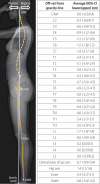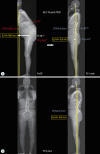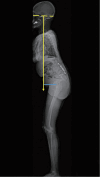Narrative Review of Clinical Impact of Head-Hip Offset Following Adult Spinal Deformity Surgery
- PMID: 37752818
- PMCID: PMC10924913
- DOI: 10.3340/jkns.2023.0168
Narrative Review of Clinical Impact of Head-Hip Offset Following Adult Spinal Deformity Surgery
Abstract
In adult spinal deformity (ASD) surgery, mechanical failure (MF) has been a significant concern for spine surgeons as well as patients. Despite earnest endeavors to prevent MF, the absence of a definitive consensus persists, owing to the intricate interplay of multifarious factors associated with this complication. Previous approaches centered around global spinal alignment have yielded limited success in entirely forestalling MF. These methodologies, albeit valuable, exhibited limitations by neglecting to encompass global balance and compensatory mechanisms within their purview. In response to this concern, an in-depth comprehension of global balance and compensatory mechanisms emerges as imperative. In this discourse, the center of gravity and the gravity line are gaining attention in recent investigations pertaining to global balance. This narrative review aims to provide an overview of the global balance and a comprehensive understanding of related concepts and knowledge. Moreover, it delves into the clinical ramifications of the contemporary optimal correction paradigm to furnish an encompassing understanding of global balance and the current optimal correction strategies within the context of ASD surgery. By doing so, it endeavors to furnish spine surgeons with a guiding compass, enriching their decision-making process as they navigate the intricate terrain of ASD surgical interventions.
Keywords: Adult spinal deformity; Compensatory mechanism; Global balance; Global spinal alignment; Head-hip offset; Mechanical failure.
Conflict of interest statement
No potential conflict of interest relevant to this article was reported.
Figures





References
-
- An S, Hyun SJ, Lee JK, Yang SH, Kim KJ. Postoperative gravity line-hip axis offset as a substantial risk factor for mechanical failure after adult spinal deformity correction surgery. Neurosurgery. 2023;92:998–1005. - PubMed
-
- Bari TJ, Ohrt-Nissen S, Hansen LV, Dahl B, Gehrchen M. Ability of the global alignment and proportion score to predict mechanical failure following adult spinal deformity surgery-validation in 149 patients with two-year follow-up. Spine deform. 2019;7:331–337. - PubMed
-
- Baum GR, Ha AS, Cerpa M, Zuckerman SL, Lin JD, Menger RP, et al. Does the Global Alignment and Proportion score overestimate mechanical complications after adult spinal deformity correction? J Neurosurg Spine. 2020;34:96–102. - PubMed
-
- Charpak G. Prospects for the use in medicine of new detectors of ionizing radiation. Bull Acad Natl Med. 1996;180:161–168. discussion 168. - PubMed
LinkOut - more resources
Full Text Sources

